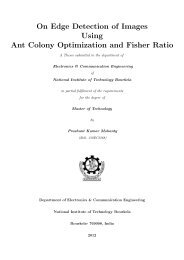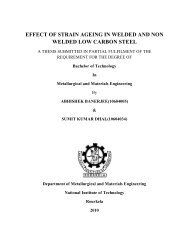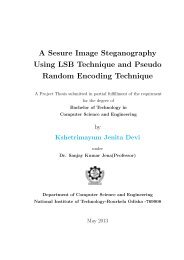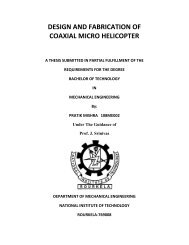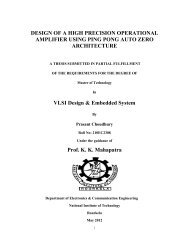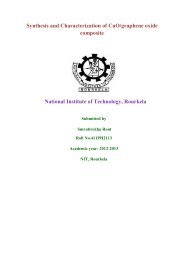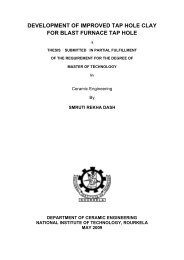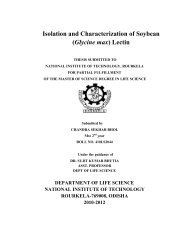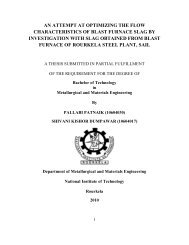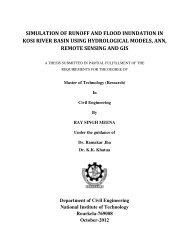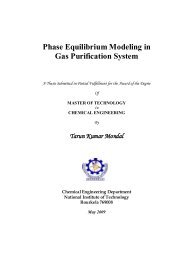analysis of transient heat conduction in different geometries - ethesis ...
analysis of transient heat conduction in different geometries - ethesis ...
analysis of transient heat conduction in different geometries - ethesis ...
You also want an ePaper? Increase the reach of your titles
YUMPU automatically turns print PDFs into web optimized ePapers that Google loves.
higher. When Biot number is more than one the <strong>heat</strong> transfer is higher which require more time<br />
to transfer the <strong>heat</strong> from body to outside. Thus the variation <strong>of</strong> temperature with time is<br />
negligible. Whereas as gradually the Biot number <strong>in</strong>crease, the <strong>heat</strong> transfer rate decrease, and<br />
thus it results to rapid cool<strong>in</strong>g. Fig 1.1 predicts, how at Biot number more than one the<br />
temperature variation with time is more as compared to Biot number with one and less than one.<br />
1.7 SOLUTION OF HEAT CONDUCTION PROBLEMS<br />
For a <strong>heat</strong> <strong>conduction</strong> problem we first def<strong>in</strong>e an appropriate system or control volume. This step<br />
<strong>in</strong>cludes the selection <strong>of</strong> a coord<strong>in</strong>ate system, a lumped or distribution formulation, and a system<br />
or control volume. The general laws except <strong>in</strong> their lumped forms are written <strong>in</strong> terms <strong>of</strong><br />
coord<strong>in</strong>ate system. The <strong>different</strong>ial forms <strong>of</strong> these laws depend on the direction but not the orig<strong>in</strong><br />
<strong>of</strong> the coord<strong>in</strong>ates, whereas the <strong>in</strong>tegral forms depend on the orig<strong>in</strong> as well as the direction <strong>of</strong> the<br />
coord<strong>in</strong>ates. Although the <strong>different</strong>ial forms apply locally, the lumped and <strong>in</strong>tegral forms are<br />
stated for the entire system or control volume. The particular law describ<strong>in</strong>g the diffusion <strong>of</strong> <strong>heat</strong><br />
(or momentum, mass or electricity) is <strong>different</strong>ial, applies locally, and depends on the direction<br />
but not the orig<strong>in</strong> <strong>of</strong> coord<strong>in</strong>ates. The equation <strong>of</strong> <strong>conduction</strong> may be an algebraic, <strong>different</strong>ial or<br />
other equation <strong>in</strong>volv<strong>in</strong>g the desired dependent variable, say the temperature as the only<br />
unknown. The govern<strong>in</strong>g equation (except for its flow terms) is <strong>in</strong>dependent <strong>of</strong> the orig<strong>in</strong> and<br />
direction <strong>of</strong> coord<strong>in</strong>ates. The <strong>in</strong>itial and/or boundary condition pert<strong>in</strong>ent at govern<strong>in</strong>g equation<br />
are mathematical descriptions <strong>of</strong> experimental observations. We refer to the conditions <strong>in</strong> time as<br />
the <strong>in</strong>itial condition and the condition <strong>in</strong> space as the boundary conditions. For an unsteady<br />
problem the temperature <strong>of</strong> a cont<strong>in</strong>uum under consideration must be known at some <strong>in</strong>stant <strong>of</strong><br />
time. In many cases this <strong>in</strong>stant is most conveniently taken to be the beg<strong>in</strong>n<strong>in</strong>g <strong>of</strong> the problem.<br />
This we say as Initial (volume) conditions. Similarly for boundary condition prescribe<br />
parameters like temperature, <strong>heat</strong> flux, no <strong>heat</strong> flux (<strong>in</strong>sulation), <strong>heat</strong> transfer to the ambient by<br />
convection, <strong>heat</strong> transfer to the ambient by radiation, prescribed <strong>heat</strong> flux act<strong>in</strong>g at a distance,<br />
<strong>in</strong>terface <strong>of</strong> two cont<strong>in</strong>uum <strong>of</strong> <strong>different</strong> conductivities, <strong>in</strong>terface <strong>of</strong> two cont<strong>in</strong>ua <strong>in</strong> relative<br />
motion, Mov<strong>in</strong>g <strong>in</strong>terface <strong>of</strong> two cont<strong>in</strong>ua(change <strong>of</strong> phase).<br />
For the surface temperature <strong>of</strong> the boundaries it is specified to be a constant or a function <strong>of</strong><br />
space and/or time. This is the easiest boundary condition from the view po<strong>in</strong>t <strong>of</strong> mathematics, yet<br />
7





